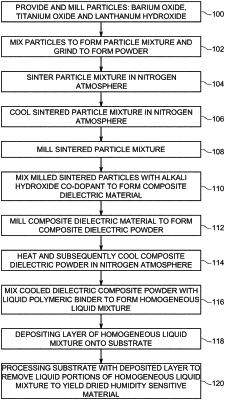| CPC C09D 11/52 (2013.01) [C09C 1/3692 (2013.01); C09C 3/041 (2013.01); C09C 3/06 (2013.01); C09D 11/037 (2013.01); C09D 11/101 (2013.01); C09D 11/102 (2013.01); G01N 27/223 (2013.01); C01P 2002/52 (2013.01); C01P 2004/62 (2013.01); C01P 2004/64 (2013.01); C01P 2006/40 (2013.01)] | 20 Claims |

|
1. A method of producing a humidity sensitive material, comprising:
providing particles of barium oxide, titanium dioxide and lanthanum hydroxide, wherein all of said particles have an average grain diameter in a range of 20-120 nanometers;
mixing 60-70 weight percent of said particles of barium oxide, 30-40 weight percent of said particles of titanium dioxide and 0.2-5.0% weight percent of said particles of lanthanum hydroxide to provide a mixture of particles;
heating the mixture of particles in a nitrogen atmosphere at a first predetermined temperature for a first predetermined amount of time to form a sintered mixture;
cooling the sintered mixture in the nitrogen atmosphere;
milling the sintered mixture to produce milled particles having diameters in a range of 50-700 nanometers;
mixing 95-99 weight percent of said milled particles and 1.0-5.0 weight percent of an alkali hydroxide to form a composite dielectric material;
milling the composite dielectric material to form a composite dielectric powder;
heating the composite dielectric powder in a nitrogen atmosphere at a second predetermined temperature for a second predetermined amount of time;
cooling the composite dielectric powder in the nitrogen atmosphere;
thereafter mixing 70-80 weight percent of said composite dielectric powder and 20-30 weight percent of a liquid polymeric binder to form a homogenous liquid mixture;
depositing a layer of the homogeneous liquid mixture onto a substrate; and
processing said substrate with said layer thereon to remove liquid portions of said liquid mixture.
|
|
17. A method of manufacturing a humidity sensor, the method comprising:
providing particles of barium oxide, titanium dioxide and lanthanum hydroxide, wherein all of said particles have an average grain diameter in a range of 20-120 nanometers;
mixing 60-70 weight percent of said particles of barium oxide, 30-40 weight percent of said particles of titanium dioxide and 0.2-5.0% weight percent of said particles of lanthanum hydroxide so as to form a mixture of particles;
heating the mixture of particles in a nitrogen atmosphere at a first predetermined temperature for a first predetermined amount of time so as to form a sintered mixture;
cooling the sintered mixture in the nitrogen atmosphere;
milling the sintered mixture to produce milled particles having diameters within a range of 50-700 nanometers;
mixing 95-99 weight percent of said milled particles and 1.0-5.0 weight percent of an alkali hydroxide so as to form a composite dielectric material;
milling the composite dielectric material to form a composite dielectric powder;
heating the composite dielectric powder in a nitrogen atmosphere at a second predetermined temperature for a second predetermined amount of time;
cooling the composite dielectric powder in the nitrogen atmosphere;
mixing 70-80 weight percent of said composite dielectric powder and 20-30 weight percent of a liquid polymeric binder to form a homogenous liquid mixture;
providing a first electrode;
printing a layer of said homogeneous liquid mixture onto said first electrode;
processing said first electrode with said layer thereon to remove liquid portions of said homogeneous liquid mixture; and
providing a second electrode on said layer after said liquid portions of said liquid mixture have been removed.
|
|
19. A method of manufacturing a humidity sensor, the method comprising:
providing a substrate having a first electrode and a second electrode, wherein the first electrode and the second electrode are separated by an electrode gap;
providing particles of barium oxide, titanium dioxide and particles of lanthanum hydroxide, wherein all of said particles have an average grain diameter in a range of 20-120 nanometers;
mixing 60-70 weight percent of said particles of barium oxide, 30-40 weight percent of said particles of titanium dioxide and 0.2-5.0% weight percent of said particles of lanthanum hydroxide so as to form a mixture of particles;
heating the mixture of particles in a nitrogen atmosphere at a first predetermined temperature for a first predetermined amount of time so as to produce a sintered mixture;
cooling the sintered mixture in the nitrogen atmosphere;
milling the sintered mixture to produce milled particles having diameters within a range of 50-700 nanometers;
mixing 95-99 weight percent of said milled particles and 1.0-5.0 weight percent of an alkali hydroxide to provide a composite dielectric material;
milling the composite dielectric material to form a composite dielectric powder;
heating the composite dielectric powder in a nitrogen atmosphere at a second predetermined temperature for a second predetermined amount of time;
cooling the composite dielectric powder in the nitrogen atmosphere;
mixing 70-80 weight percent of said composite dielectric powder and 20-30 weight percent of a liquid polymeric binder to form a homogenous liquid mixture;
printing a layer of said homogeneous liquid mixture onto said substrate so as to fill the electrode gap and cover portions of the said first electrode and said second electrode; and
processing said substrate with said layer thereon to remove liquid portions of said homogeneous liquid mixture.
|